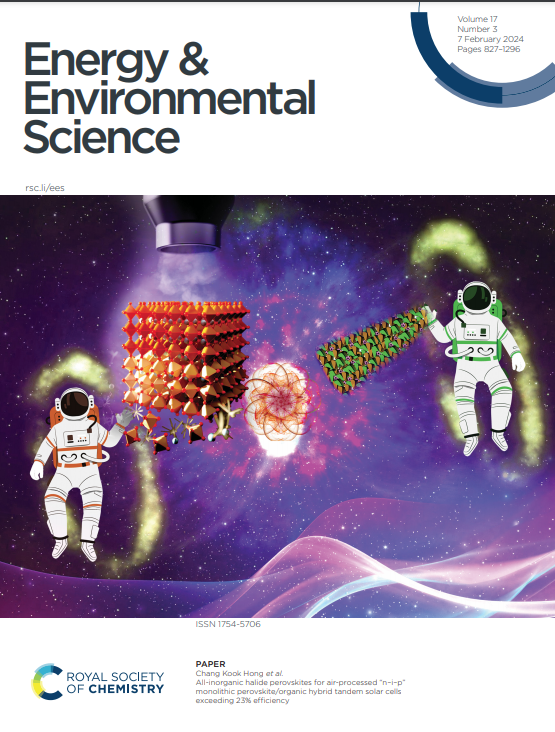Photoelectrochemical nitrate denitrification towards acidic ammonia synthesis on copper-decorated black silicon
IF 32.4
1区 材料科学
Q1 CHEMISTRY, MULTIDISCIPLINARY
引用次数: 0
Abstract
Nitrate electroreduction to ammonia has broad prospects as a complementary route to the energy-intensive Haber-Bosch industry. Currently, most electrocatalytic NO3−-to-NH3 transformations are achieved in alkaline electrolyte, which not only requires a large power supply but also poses additional challenges for accurate quantitation and large-scale separation of NH3. Herein, the silicon nanowire (black silicon) uniformly modified with Cu nanoparticles (Cu-Si NWs) is designed for photoelectrochemical nitrate reduction (PEC NO3RR) in strong acid electrolyte. Under AM 1.5 G illumination, the Cu-Si NWs achieves a remarkably positive onset potential of 0.3 V vs. RHE and an impressive saturated photocurrent density of −34.29 mA cm−2 in 0.5 M H2SO4. More importantly, the Faradaic efficiency of ammonium (NH4+) and corresponding solar-to-NH4+ efficiency reach up to 97.03% and 51.07%, respectively. Mechanistic investigations uncover the proper Schottky contact in Cu/Si interfaces facilitates charge transfer effectively, contributing to the low onset potential and high photocurrent density. In-situ experiments and theoretical analysis have further confirmed that the incorporation of Cu effectively accelerates the activation and protonation steps of NO3–. Moreover, the PEC system exhibits excellent stability and great potential in environmental remediation in simulated industrial wastewater treatment. This work introduces a strategy for fabricating highly efficient PEC devices for diminishing nitrate contaminant in strong acid media.在铜装饰的黑硅上进行光电化学硝酸盐脱硝以实现酸性氨合成
硝酸盐电还原为氨气作为能源密集型哈伯-博施工业的补充途径具有广阔的前景。目前,大多数电催化 NO3 转化为 NH3 的过程都是在碱性电解液中实现的,这不仅需要大量的电力供应,还对 NH3 的精确定量和大规模分离提出了额外的挑战。本文设计了均匀修饰有铜纳米颗粒的硅纳米线(黑硅)(Cu-Si NWs),用于强酸电解液中的光电化学硝酸盐还原(PEC NO3RR)。在 AM 1.5 G 光照下,Cu-Si NWs 在 0.5 M H2SO4 中的起始电位为 0.3 V(相对于 RHE),达到惊人的正值,饱和光电流密度为 -34.29 mA cm-2。更重要的是,铵(NH4+)的法拉第效率和相应的太阳能转化 NH4+ 的效率分别高达 97.03% 和 51.07%。机理研究发现,铜/硅界面中适当的肖特基接触可有效促进电荷转移,从而实现低起始电位和高光电流密度。原位实验和理论分析进一步证实,铜的加入有效地加速了 NO3- 的活化和质子化步骤。此外,该 PEC 系统在模拟工业废水处理的环境修复中表现出卓越的稳定性和巨大的潜力。这项研究提出了一种制造高效 PEC 器件的策略,以减少强酸介质中的硝酸盐污染物。
本文章由计算机程序翻译,如有差异,请以英文原文为准。
求助全文
约1分钟内获得全文
求助全文
来源期刊

Energy & Environmental Science
化学-工程:化工
CiteScore
50.50
自引率
2.20%
发文量
349
审稿时长
2.2 months
期刊介绍:
Energy & Environmental Science, a peer-reviewed scientific journal, publishes original research and review articles covering interdisciplinary topics in the (bio)chemical and (bio)physical sciences, as well as chemical engineering disciplines. Published monthly by the Royal Society of Chemistry (RSC), a not-for-profit publisher, Energy & Environmental Science is recognized as a leading journal. It boasts an impressive impact factor of 8.500 as of 2009, ranking 8th among 140 journals in the category "Chemistry, Multidisciplinary," second among 71 journals in "Energy & Fuels," second among 128 journals in "Engineering, Chemical," and first among 181 scientific journals in "Environmental Sciences."
Energy & Environmental Science publishes various types of articles, including Research Papers (original scientific work), Review Articles, Perspectives, and Minireviews (feature review-type articles of broad interest), Communications (original scientific work of an urgent nature), Opinions (personal, often speculative viewpoints or hypotheses on current topics), and Analysis Articles (in-depth examination of energy-related issues).
 求助内容:
求助内容: 应助结果提醒方式:
应助结果提醒方式:


